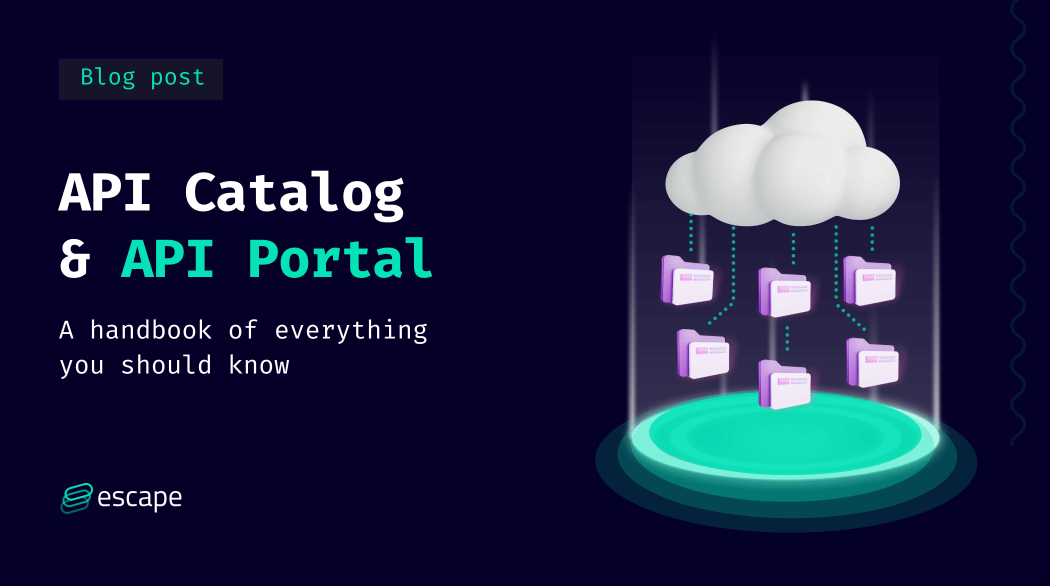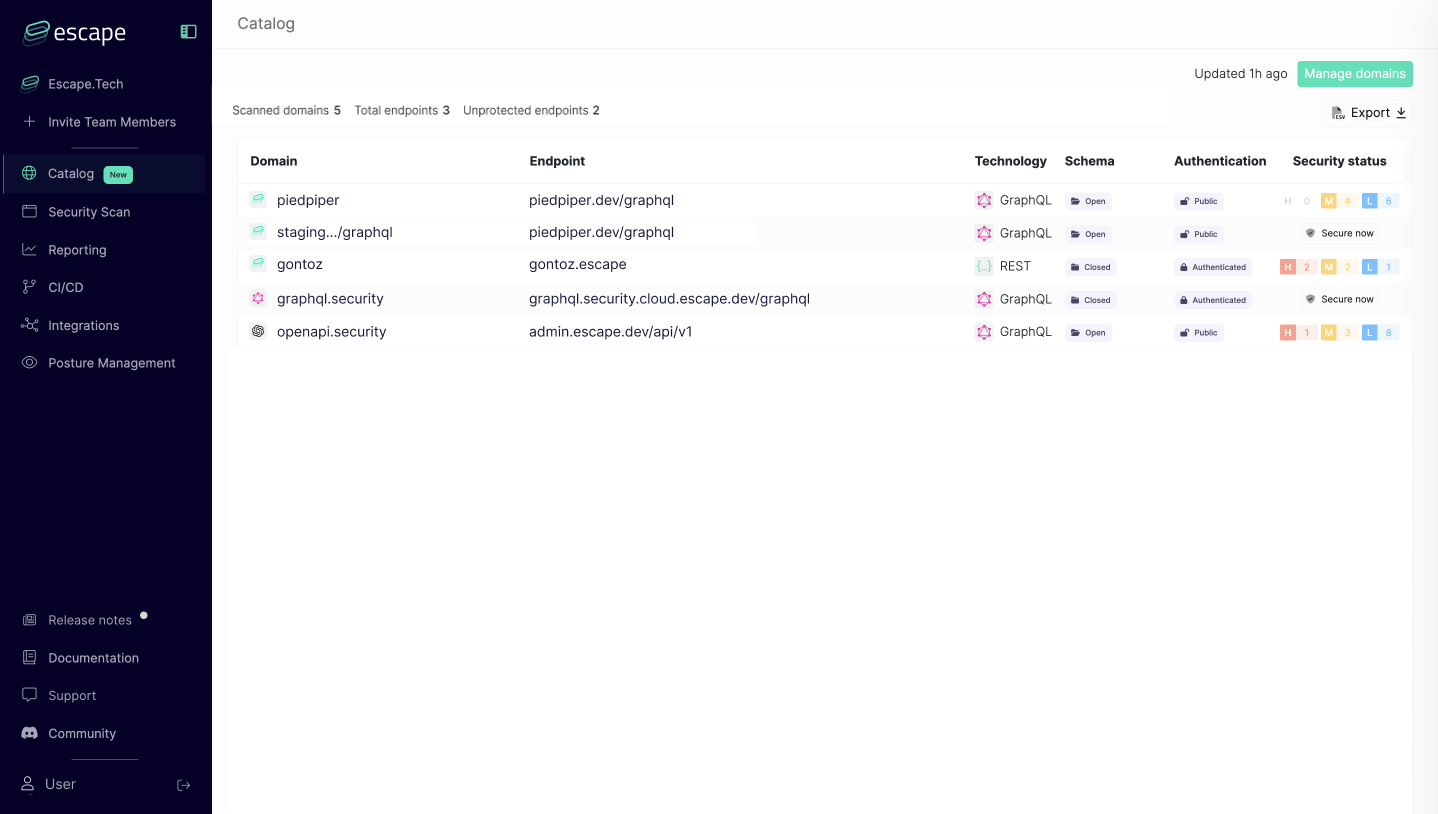API Catalog & API Portal: A handbook of everything you should know
Discover the importance of API catalogs, their differences from API portals & gateways, and how to ensure optimal API management and security.

You've probably come across terms like API Catalog, API Portal, API Gateway... and found yourself scratching your head, thinking, what kind of tech magic is this? Are you feeling lost amidst these buzzwords that everyone seems to be throwing around? If you want to catch up, grasp these concepts, and determine which solution suits your needs, you've landed in the right spot!
Note: We will be using the term API Catalog as a generic term in this first part, and we'll differentiate "catalog", "portal" and "gateway" in the next sections. While features mentioned may vary from a solution to another, this is a wide view of what features you might expect to see in an API catalog/portal solution.
What is an API catalog?
At its core, an API catalog is comparable to a digital library of APIs – a systematic inventory where APIs, whether they're designed for public consumption or internal use, find their space. It's a hub where these APIs are referenced, categorized, and can be presented alongside their accompanying documentation, authentication details, specifications, and other critical metadata. But what makes an API catalog stand out in a sea of technological tools? Let's delve deeper.
The essence of an API Catalog
- Comprehensive Inventory: In a rapidly evolving digital landscape, it's essential to have a unified place to turn to for a snapshot of all the APIs an organization operates or relies on. The API catalog fills this need, offering an overview of every API – its purpose, its endpoints, its parameters, and so on.
- Public and Private APIs: API catalogs are versatile. They can be the go-to for a developer seeking details on an internal API, or they can serve as a gateway for external stakeholders looking to integrate with the company's public APIs.
- For Everyone in the Organization: The utility of an API catalog isn't restricted to the technical team. Whether you're a developer scoping out the available tools for your next project, a product manager evaluating dependencies, or a business lead wanting to understand external integrations, an API catalog is your compass.
Tools and features: beyond just a list
While at a glance, an API catalog may seem like a simple list, the depth of what modern tools offer is significant. Advanced API catalogs/portals often come with a suite of tools:
- Authentication Management: From OAuth to API keys, the catalog can provide clarity on how to connect.
- Scope Control: Ensuring the right people have access to the right data is crucial. API catalogs often allow for refined scope controls, ensuring a developer in one team doesn't inadvertently access data they shouldn't.
- In-depth Documentation: This includes details on how to use the API, common use cases, potential pitfalls, and examples.
- API Schemas Centralization: Be it OpenAPI, SOAP, GraphQL, or any other format, a good catalog offers a unified view.
Private API Catalogs
In today's tech-driven era, as organizations shift towards a microservices architecture, the number of internal APIs multiplies exponentially. These private APIs, often unseen by the end-users, are the intricate gears that keep the machinery of businesses running smoothly. Private API catalogs, therefore, are not just organizational tools; they are strategic assets. Here's why:
1. Central Repository: With the proliferation of microservices, organizations churn out a myriad of internal APIs. A private API catalog consolidates these, ensuring that every piece of the puzzle is accounted for and easily accessible.
3. A Tool for All: While developers use it as a go-to for technical details, management and stakeholders leverage the API catalog for a holistic view of the company's services. It serves as a bridge between technical intricacies and high-level business strategies.
4. Security and Access Control: Private API catalogs fortify security by providing granular control over access. It ensures sensitive APIs are shielded and only accessible to those with the right permissions.
5. Efficient Knowledge Transfer: Onboarding becomes a breeze with a catalog in place. New team members can quickly get acquainted with the available tools, ensuring a smooth transition.
6. Collaboration: A catalog fosters a culture of shared knowledge, enabling developers to exchange insights and updates, driving innovation from within.
7. Compliance Simplified: Documenting every API's purpose and data flow is a cornerstone of regulatory compliance, made easier with a structured catalog.
8. Seamless Versioning: As APIs evolve, catalogs ensure everyone stays updated, mitigating potential disruptions due to deprecated features or changes.
Public API Catalogs
In the realm of digital products, APIs have taken center stage. For enterprises, particularly those dealing with API as a product or API as a service, making their APIs publicly available is not just a choice—it's a necessity. But why is this important, and how is it achieved?
Side Note: When we refer to API as a Product or API as a Service, we're highlighting a modern business approach where APIs aren't just technical tools. Instead, they're central offerings, designed and marketed with user experience and value delivery in mind. In this model, APIs are the product offered by companies and are usually provided to consumers on a subscription or pay-per-use basis.
APIs: From Backend to Forefront
Historically, APIs have been behind-the-scenes tools. However, with the surge in digital ecosystems, API-driven integrations have become commonplace. Now, APIs are not just tools; they are products in their own right. This shift has led to the rise of public API catalogs.
A Window to the Digital Offerings
Public API catalogs serve as an exhibition space. They're the storefronts showcasing an enterprise's digital products, presenting a user-friendly interface that simplifies API consumption. Through them, developers can explore, test, and integrate these APIs into their applications with ease.
More Than Just a List
Much like their private counterparts, public API catalogs come equipped with a suite of tools and resources. Whether it's detailed documentation, integration guides, or testing environments, these catalogs are designed to assist and engage API consumers.
API Marketplaces: The Digital Malls
Taking it a step further, some API products find their place in larger ecosystems called API marketplaces. Platforms like RapidAPI and APILayer serve as hubs, listing various APIs from different providers that could be compared to stores in a shopping mall. These marketplaces not only increase the visibility of individual APIs but also offer consumers a one-stop-shop experience.
Security Considerations
Public visibility comes with its challenges, particularly in the cybersecurity domain. It's crucial for providers and consumers to ensure their APIs are robust and secure. At Escape, we've gone a step further, running advanced security scans on these public APIs. Curious about our findings? Dive into our comprehensive analysis and rankings of numerous public APIs on apirank.dev. Learn more in our article: https://escape.tech/blog/apirank-dev-we-scanned-and-ranked-5651-public-apis-on-the-internet/
Let's address the elephant in the room: API Catalog vs. API Portals
Dive into the world of APIs, and you'll quickly stumble upon terms like "API Catalog" and "API Portal". While they might seem like just more tech jargon at first, there are subtle differences between them. Let's demystify these terms and keep things simple.
What's the difference between API Catalogs and API Portals?
API Catalogs are your go-to directories. They list and organize every API, providing a quick overview of what's available. Think of them as the library of the API world.
On the flip side, API Portals are like hands-on workshops for developers. They don't just list APIs – they offer detailed guides, authentication help, and sometimes even a sandbox for testing. If the catalog tells you "what's there", the portal shows you "how to play with it".
Buzzwords aside
Yes, the tech world loves its buzzwords. However, it's essential to recognize that as the digital ecosystem evolves, the distinction between these two is becoming increasingly blurry. As new needs arise and solutions emerge, the boundary between what's considered a catalog and what's seen as a portal is less defined. Many modern tools offer a blend of both, making strict categorization challenging.
For the purpose of this article, and to avoid getting too tangled in semantics, we'll lean on the term "API Catalog" as a broader umbrella. This encompasses both the listing and organizational aspects of a catalog and the more interactive, developer-centric features commonly found in portals.
What about API Gateways? What's the difference with an API Catalog/Portal?
Diving deeper into API tools, the term "API Gateway" often comes up, and it's crucial to understand its distinction from API Catalogs or Portals.
API Gateway: The traffic manager
In essence, an API Gateway acts as a traffic manager. Unlike catalogs or portals that serve as directories or interfaces, gateways directly affect APIs' functions. They consolidate multiple backend services into a unified API, manage requests, and enhance overall performance and security. Some of its core features include:
- Aggregation: Combining multiple services into one accessible API.
- Monitoring and Analytics: Providing insights into API performance and usage.
- Load Balancing: Distributing API requests across servers to ensure stability.
Gateways vs. Catalogs/Portals: A quick comparison
API Catalogs or Portals are about organization, presentation, and ease of access. They give you a view of the APIs available and sometimes tools to engage with them.
On the other hand, an API Gateway operates at a more integral, technical level, directly influencing how APIs perform and interact.
Interestingly, as technology evolves, many API Gateways adopt features typical of Catalogs or Portals, such as documentation and user management. It's a testament to the blending of roles and functionalities in the digital space.
Why you should use an API Catalog
In our increasingly digital world, the advantages of an API catalog are multifold. Here's why you should consider using one:
- Centralized Overview: Have a single view of all the APIs your organization interacts with, both internal and external.
- Enhanced Productivity: Developers can quickly discover, understand, and integrate APIs into their projects.
- Collaboration Boost: A unified platform fosters better communication and collaboration across teams.
- Optimized API Consumption: With detailed documentation and guides, you ensure that the APIs are used in the most effective way.
- Accessibility: Be it for management, developers, or external stakeholders, a catalog provides accessible insight into the organization's digital assets.
Limitations
While they're super helpful tools, API catalogs have their constraints:
- Manual Upkeep: Regular updates are needed, and there's the risk of overlooking some API registrations. In some cases, this can rapidly become labor intensive and a pain for both developers and managers.
- Safety Concerns: Not all APIs listed might be secure or reliable. Before consuming any API, it's crucial to vet its safety. Delve deeper into the security concerns with the report on The State of Public APIs in 2023.
Existing solutions
The market offers a variety of solutions tailored to different needs. Some notable ones include:
- Postman: Not just an API client but also a platform offering features like mock servers, automated testing, and API documentation.
- Swagger Hub: Centralized platform for building and managing APIs.
- Kong: An API gateway that also features a developer portal.
- Insomnia: An open-source Postman alternative built by Kong Inc.
If you're a Postman or Insomnia user, you'll be interested in our related articles:
- Graphman: An open-source tool to automatically convert GraphQL APIs to Postman (and Insomnia) collections.
- Escape x Postman integration: explore your API vulnerabilities found by Escape directly in Postman.
Escape's API Catalog solution
In the world of APIs, security is paramount. As APIs proliferate in the digital landscape, knowing what you have and ensuring its security becomes challenging. Enter Escape's API catalog solution, merging security with the functionality of an API catalog.

Features at a glance
Automated Discovery: Manual entry is the major hurdle with most internal API catalogs. Human intervention means there's always the risk of missing something. Escape’s solution automatically discovers APIs across your domains, ensuring a comprehensive and updated list.
Attack Surface Management (ASM): Our catalog is more than just an inventory. It provides a detailed view of your entire API 'attack surface'. With metadata annotations, you can instantly gauge if an API is public, requires authentication, or has its schema accessible.
One-Click Securitization: Found an API that needs added security? Our platform springs into action with just a click, fortifying your discovered APIs. It's not just about knowing; it's about proactive protection.
Dive deeper
For an in-depth exploration of Escape's API catalog and its benefits, check out our detailed Escape Catalog article.
Conclusion
While numerous API catalog solutions exist, Escape's offering stands apart. It's not just about organization; it's about security. By combining traditional catalog tools and our solution, you'll get the best of both worlds: optimal management and unparalleled security for your APIs.
Intrigued by what you've read? Experience the robustness of Escape's API catalog for yourself.
